ISSN ONLINE(2319-8753)PRINT(2347-6710)
ISSN ONLINE(2319-8753)PRINT(2347-6710)
Vinay R.B1, Ranjith.A2, Bharath.A3
|
| Related article at Pubmed, Scholar Google |
Visit for more related articles at International Journal of Innovative Research in Science, Engineering and Technology
Transmission towers are generally analyzed by linear static analysis methods and second order analysis are usually neglected. Linear static analysis does not reflect the structural characteristic of transmission towers. Structures that tend toward more taller and lighter, it will result in potentially more significant to the P-delta effects. The Present work describes the structural optimization of transmission line tower. In the study 400kV double circuit tower is modeled using Angle and Tubular sections using STAAD.Pro V8i software and analyzed for Wind load by using linear static and P-delta analysis in order to study the importance of P-delta analysis for transmission tower . After analysis, the comparative study is presented with respective to cost and displacement for both sections. A saving in steel weight up to 20.9% resulted when tubular section is compared with angular section. The displacement values increased when tower is analyzed for P-delta as compared to static analysis.
Keywords |
| Angle section, Tubular section, Wind load, Displacement, P-delta analysis, Optimization of weight. |
I. INTRODUCTION |
| The use of electric power has become an increasingly important part of the economy of industrial countries. The development of thermal generating stations, remote hydro-electric power plants and the interconnection of formerly independent electric systems have given rise to the need for extra high voltage (EHV) electric transmission lines. At the beginning of World War I, 115KV was considered high voltage. Since that time, load growth and transmission distances have increased to the point where facilities for 500KV and 800KV transmissions are being constructed. Transmission tower is a medium to carry power loads from one station to another station. Transmission tower supports the phase conductors and earth wires of transmission line. The interruption in transmission line system affects the country economic growth. Transmission tower consists of several types and designed accordance with the tower height and capacity of lower support load from the conductor, compressive load, wind load, vertical load, longitudinal load, uplift load. |
| ALAA.C.GALEB et al. [1] have considered 1S2 and 2S2 132KV transmission towers and investigated on optimum design of transmission towers subjected to wind and earthquake loading and also aimed to reduce the weight by changing geometry like Angle section, Tube section, Pipe section with different bracings like X and K bracing and tower is analyzed using STAAD PRO V.2006. In [2], the author has used eight models of transmission tower structure were analyzed in STAAD.PRO 2007 by using linear static analysis and P-Delta analysis based on several widths like 2.5m, 3.5m, 4.5m, 5.5m and several bracing configurations like X, diagonal and K bracing. In [3], the author has considered 132 KV double circuit transmission line tower for optimizing structure with respect to configuration and different materials as variable parameters. The basic model is 4.46m base width, 30m height consisting of 6 panels, second model of 5.2m base width and 6 panels, third model of 6.0m base width and 6 panels, fourth model of 4.6m and 4 panels, and fifth model of 4.6m and 3 panels. High Tensile Steel (350 Mpa) is assigned for Leg member angle size and by assigning remaining members angle size of Mild Steel (250 Mpa). In [4], the authors have studied the performance of intact structure under medium wind intensity of 1.5 kN/m2 and considered tower height of 21m arranged in 9 panels at different levels and tower was to transmission voltage of 132 KV is presented. In [5], the authors describes the analysis and design of two self-supporting 400 KV double circuit steel suspension tower using common parameters like constant height, bracing system with angle section is carried out. |
| The main objectives of this work is to study the significance of P-Delta analysis for transmission tower structure, to study the stability of transmission line tower structure for different geometry and to optimize the tower by considering angle and tubular sections. In this paper transmission tower considering angle section and tubular section subjected to wind load is analyzed by using linear static analysis and P-delta analysis is presented. |
II. EXPERIMENTAL CONFIGURATION OF THE TOWER |
| In the present work, a typical 400 KV double circuit transmission line tower is considered, for optimizing the structure with respect to yield strength of the tower member as variable parameters. The tower is to be modelled and analyzed using STAAD.Pro V8i structural analysis software to obtain the optimum design of towers. The tower configuration is shown in table1 and figure 1. As per the guide lines of KPTCL [11], table 2 lists the details of some parameters typical to a 400kv double circuit suspension type tower and table 3 lists the details of some parameters of conductor and ground wire .Loads and Load combinations criteria on the ground wire, conductor and on the tower are found using IS:802 (Part 1/Sec 1)-1995 |
 |
| Elevation of the tower configuration of 400 KV double circuit which is sketched with the help of AutoCAD as shown in figure 1. |
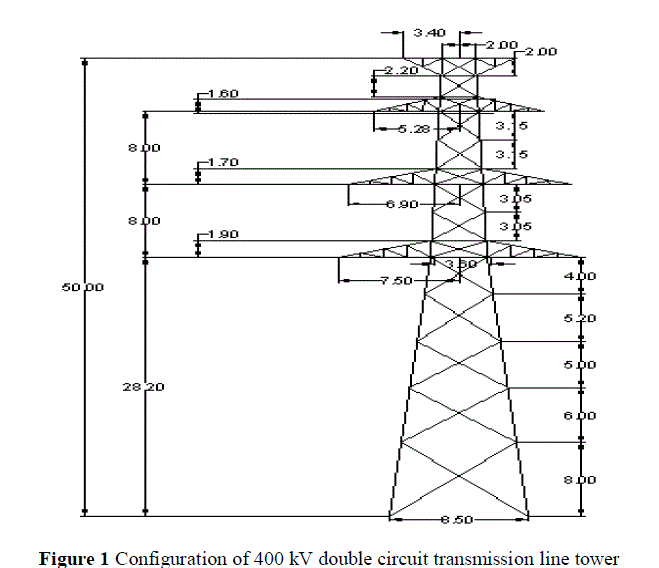 |
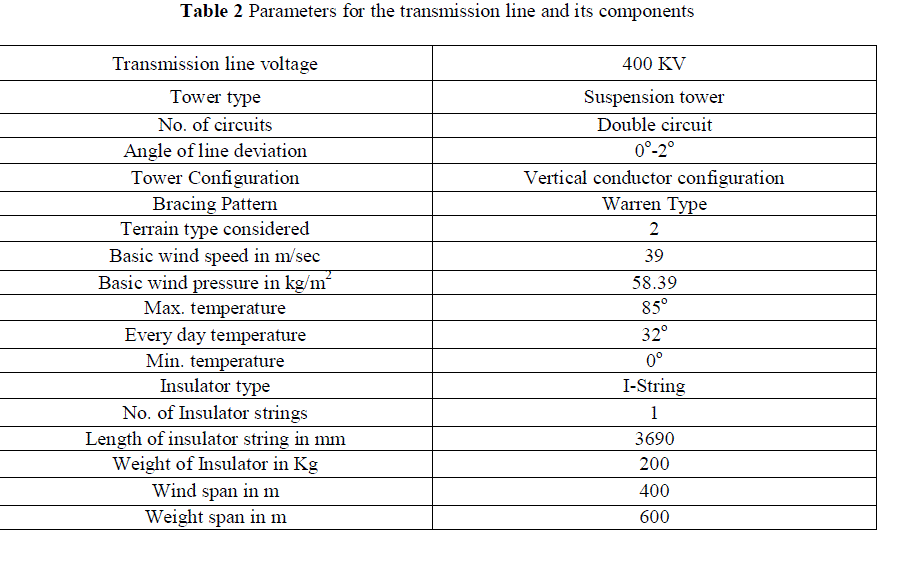 |
| Parameters for transmission line and its components which are used in the tower dimension calculation and wind load calculation as shown in table 2. |
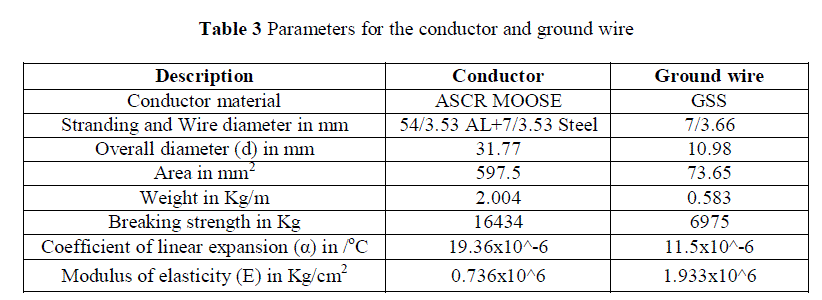 |
| Parameters for conductor and ground wire which are used for calculation of wind load and self-weight of tower as shown in table 3. |
III. MODELLING APPROACH |
| The general package STAAD. Pro V8i has been used for analysis and design. In this study tower is modeled as a 3D space by considering tower as a truss and assigned mild steel of grade 250 N/mm2 for angle section and High tensile steel of grade 310 N/mm2 for tubular section. In this study Wind load considered is acting in X and Z directions. Loads and Load combinations are considered as per IS-802 are used in linear static analysis but in case of P-delta analysis load combinations are not considered instead of that repeat load is considered. |
IV .RESULTS AND DISCUSSION |
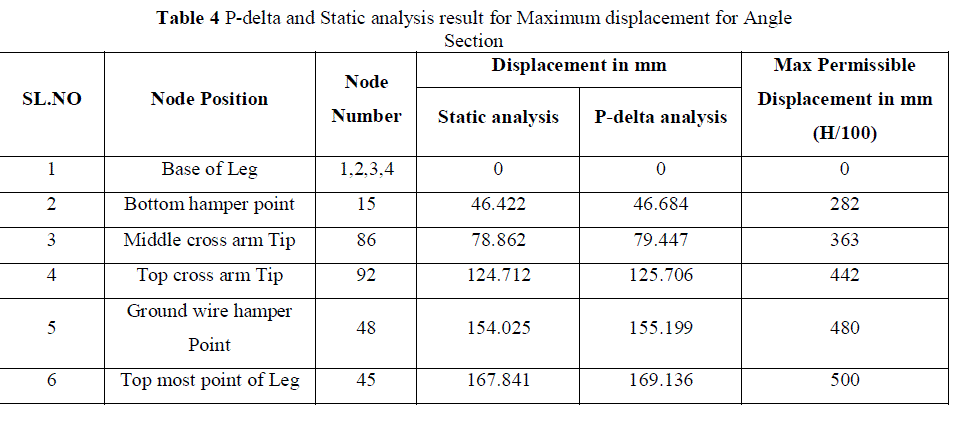 |
| The displacement values obtained from the result for different positions of the tower, which is analyzed using linear static analysis and P-delta analysis for angle section and maximum permissible displacements values obtained by dividing height by 100 for different positions of the tower as shown in table 4. |
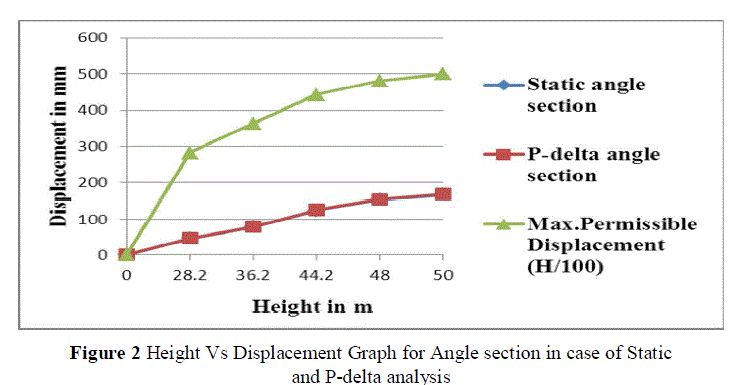 |
| There is marginal increase in the displacement values in case of angle section for P-delta as compared to static analysis as shown in figure 2. The displacement values are increased by 0.8% and these values are within the Permissible limits. |
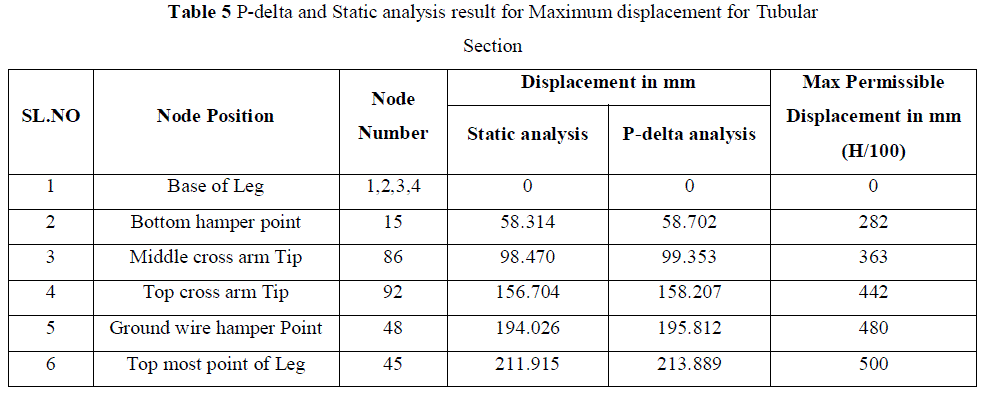 |
| The displacement values obtained from the result for different positions of the tower, which is analyzed using linear static analysis and P-delta analysis for tubular section and maximum permissible displacements values obtained by dividing height by 100 for different positions of the tower as shown in table 5. |
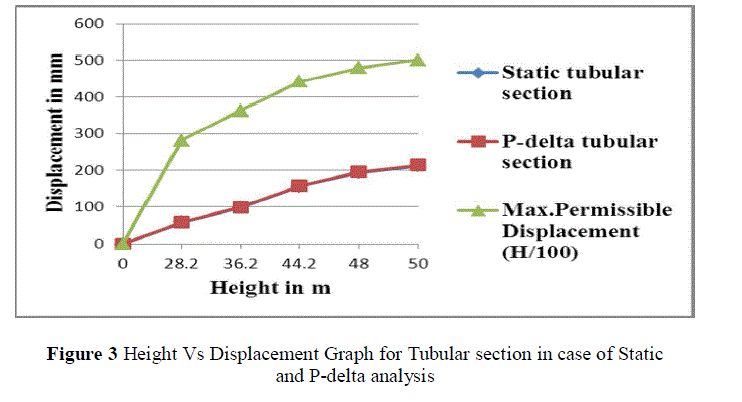 |
| There is marginal increase in the displacement values in case of tubular section for P-delta analysis as compared to static analysis as shown in figure 3. The displacement values are increased by 1% and these values are within the Permissible limits. |
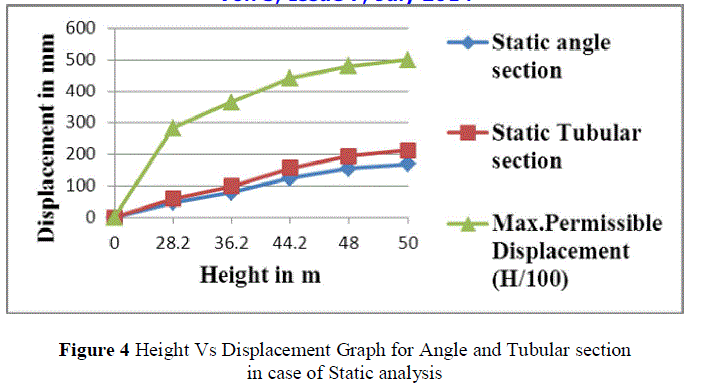 |
| There is increase in the displacement values for tubular section as compared to Angle section in case of static analysis as shown in figure 4. The displacement values are increased by 20.8% and these values are within the Permissible limits. |
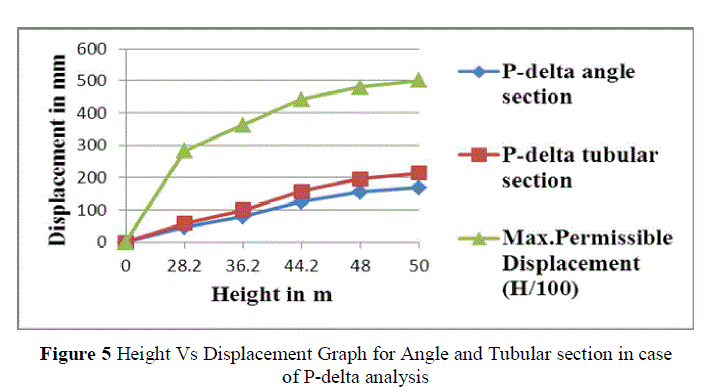 |
| There is increase in the displacement values for tubular section as compared to Angle section in case of P-delta analysis as shown in figure 5. The displacement values are increased by 20.9% and these values are within the Permissible limits. |
V. CONCLUSIONS |
| The following are the major conclusions drawn from the Present study. |
| • The study of different loading conditions on structure is very important to recognize the case that will cause the larger deflection in tower model and to decide which case will be optimized. |
| • The tower provided with angle section and X-bracing is found to increase in the displacement due to second order effect (about 0.8% of that of linear effect). |
| • The tower provided with tubular section and X-bracing is found to increase in the displacement due to second order effect (about 1% of that of linear effect). |
| • The tower provided with tubular section and X-bracing is found to increase in the displacement than angle section due to linear effect (about 20.8% of that of angle section). |
| • The tower provided with tubular section and X-bracing is found to increase in the displacement than angle section due to second order effect (about 20.9% of that of angle section). |
| • The tower with tubular section and X-bracing has an optimum weight smaller than the tower with angle section (about 24.53% of that of angle section) |
References |
|